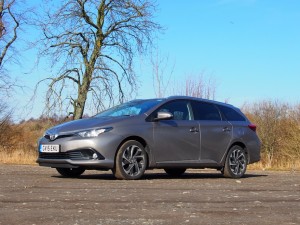… Toyota Auris Touring Sports 1.2T …
 Toyota’s Auris is a big car with a small engine, and yet it’s not and it hasn’t. Although it looks big, it’s only 285mm longer than the Auris Hatchback and the four cylinder engine under the bonnet has a turbo. In other words, it’s a very deceiving motor.
Toyota’s Auris is a big car with a small engine, and yet it’s not and it hasn’t. Although it looks big, it’s only 285mm longer than the Auris Hatchback and the four cylinder engine under the bonnet has a turbo. In other words, it’s a very deceiving motor.
It’s the proportions which make the car look quite big when you see it sat on its own, but park it beside other cars and you realise this really is a C segment motor. There was another surprise when sat inside. It has plenty of head, shoulder and leg room enabling the driver to benefit from a very comfortable driving position which I benefitted on the 285 mile round trip to the Malcolm Wilson Rally.
The boot is pretty big too with enough space for all the gubbins needed to follow a rally – a selection of wet and dry weather gear and footwear to cope with the uncertainties of the great British outdoors, plus various camera bags and computer stuff and of course a folding bicycle. Essential for getting round service parks!
With the one-touch rear seats folded flat, the loadspace is 2,047 mm long and 1,452 mm wide and has a maximum height of 890 mm which can be reduced to 760 mm with the double floor deckboard in place. That results in a very low loading floor at the rear and yet there is still room for a spacesaver wheel under the floor. A much better idea than the increasingly standard ‘skoosh and blow puncture repair kit’ especially for an estate car. It also has a 12v socket at the rear and a boot lamp.
Just one thing though, sitting on the rear tailgate lip to pull on your boots risks getting the back of your trousers wet or dirty from the protruding bumper!
 Apart from that, it has all the makings of an ideal service barge, or maybe not. That’s down to the ‘wee’ engine under the bonnet. Although the introductory paragraph describes it as a four cylinder, don’t get your hopes up. The capacity is a mere 1197cc. It’s tiny, but it’s got a turbocharger.
Apart from that, it has all the makings of an ideal service barge, or maybe not. That’s down to the ‘wee’ engine under the bonnet. Although the introductory paragraph describes it as a four cylinder, don’t get your hopes up. The capacity is a mere 1197cc. It’s tiny, but it’s got a turbocharger.
It’s also got Toyota’s VVT-i intelligent variable valve timing system with a direct injection fuel system and a water-cooled turbo and heat exchanger which has resulted in an output of 114bhp. More impressive is the torque which is generated, 184 Nm between 1500 and 4000rpm. The red sector on the rev counter starts at 5600rpm and goes all the way up to 8500, but I didn’t get anywhere near that. There was no need. The car pulls well from rest and gets through the gears just as fast as you need on Britain’s busy roads.
Small engines and big cars usually means high fuel consumption and although Toyota claims up to 60 mpg, I was happy enough with 40 mpg on the motorway and Lake District country roads carrying all my gear. Admittedly the small capacity engine needed a bit of extra encouragement from the 6 speed gearbox on some of the steeper, twistier roads above Keswick at times, but that just made it all the more fun.
 Completing the package was ride comfort. Toyota has revised the front MacPherson strut suspension and reduced the spring rate while the shock absorbers have been fine-tuned to combine ride comfort with enhanced stability and excellent steering response. At the back, torsion beam rear suspension has been used and the ride height has been raised by 10mm.
Completing the package was ride comfort. Toyota has revised the front MacPherson strut suspension and reduced the spring rate while the shock absorbers have been fine-tuned to combine ride comfort with enhanced stability and excellent steering response. At the back, torsion beam rear suspension has been used and the ride height has been raised by 10mm.
That results in a car which was a treat to drive and which at no time felt underpowered. What a cracking wee engine and a fine motor overall.
As ever, the question is, would I have one? Yup, I think I would, and I don’t think I would need the bigger 1.6 litre petrol or 2 litre diesel unless I was towing.